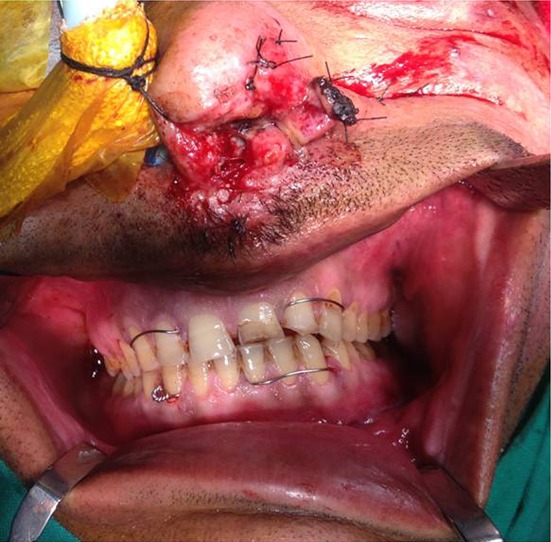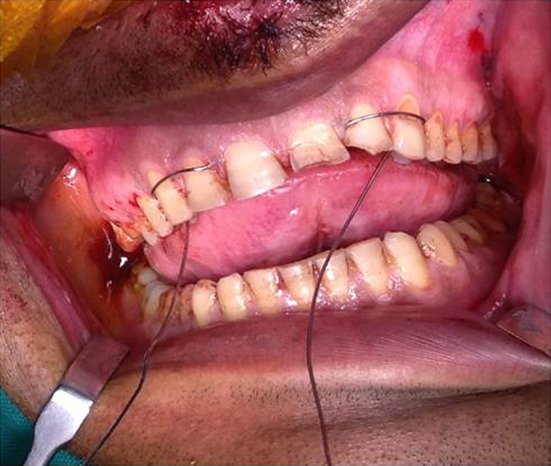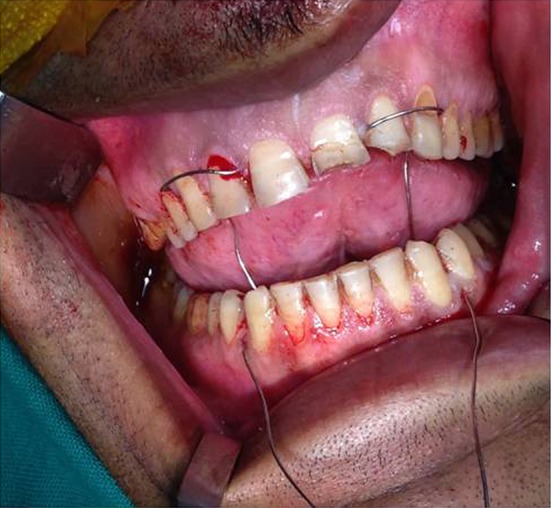Abstract
Intermaxillary fixation (IMF) is required before plating to achieve premorbid relationship of mandibular and maxillary teeth. We recommended the use of single wire for achieving IMF using 24 gauze stainless steel wire, which is an easy, fast, economical and minimally invasive technique.
Keywords: IMF, Single wire, 24 Gauze wire, Rai Technique
Intermaxillary fixation (IMF) is commonly done with the help of IMF screws, arch bars, eyelet wiring, direct interdental wiring [1], buccolingual stabilization [2] and loop-designed wire [3]. All these techniques are time consuming and require expertise. We recommended the use of single 24 gauze wire for achieving IMF (Fig. 1). In cases where wire was impinging on the mucosa, the wire was curved around the cervical margins of the teeth interdentally to achieve IMF (Fig. 2).
Fig. 1.

Model showing IMF with a single wire
Fig. 2.

Photograph showing wires placed on the cervical margins of the teeth to achieve IMF
Technique
A 24 gauze wire is used after stretching it 10 % from its original length. The wire was inserted from palatal side between canine and first premolar from one side, then taken out on buccal side curved around the canine and lateral incisor and then inserted into the inter-dental space again to bring it out on palatal side, it is then curved around the cervical margin of central incisors and brought out on buccal aspect.
The same wire was then curved around the buccal surface of lateral incisor and canine teeth and from the inter-dental space, and again brought out on palatal side (Fig. 3).
Fig. 3.

Photograph represents wires placed in the maxillary arch
To avoid mucosal impingement the wire from left side of the mandible was curved around the buccal surface of the canine, lateral and central incisior and brought lingually (Fig 4). The same wire then curved around the lingual surface of the central and lateral incisors of the right side and brought bucally from the inter-dental space and tied with the other end the wire to achieve IMF (Fig 2).
Fig. 4.

Photograph represents wires inserted from lingual side of mandible
Advantages of IMF with single wire
Easy and simple.
Quick.
Less expensive.
Easy to maintain oral hygiene.
Painless procedure.
Less chance of percutaneous injury to fingers.
Excellent technique for intra operative and short-term IMF.
Requires less armamentarium.
Can be used in non-displaced or minimally displaced fracture for closed reduction.
Disadvantages
Cannot be used in partially edentulous patients.
Proper inter-dental space is mandatory.
Long term stability is questionable.
Indications
In management of nondisplaced and favourable fractures of maxillofacial region.
Intra-operative IMF for open reduction and internal fixation.
Closed reduction of non-displaced coronoid process, Lefort I fractures.
Can be used in orthognathic and in tumor resection surgeries.
In patients with myofacial pain dysfunction syndrome who require short-term IMF.
Can be used in mass casualties such as war injuries or natural calamities for quick IMF.
Contraindications
In panfacial fractures.
In unfavourable, displaced fractures of maxillofacial region.
Patients who require long term IMF.
Patients who require pre/post IMF elastic traction.
In partially edentulous patients.
Discussion
The aim of this technical note was to introduce a new and quick method of achieving IMF with fewer complications. IMF screws and arch bars are commonly used for IMF, but they are time consuming, and screws can cause damage to roots of the teeth [4], IMF with arch bars required multiple wires which can cause damage to the fingers of the operator and also oral hygiene is difficult to maintain [5]. Direct interdental wiring again required multiple wires and is time consuming [6]. In buccolingual stabilization, wires are used on both the sides of the arch and two wires are required and if one breaks, we have to open both the wires and again have to do IMF [2]. In IMF by loop-designed wire four loops were made [3] which can irritate the tongue and sometimes cause ulceration and is again technique sensitive. Use of single wire for IMF eliminates all these complications.
The single wire on the other hand, cannot be used in panfacial and severely displaced fracture management. The nondisplaced and favourable fracture of dentate segment can be managed by single wire IMF. However, long term IMF with a single wire is questionable. The IMF with arch bars is the first choice when long term (more than 6 weeks) IMF is required [1]. The present new technique can replace the older techniques only after they have been extensively studied in multicentric studies with large sample size.
Compliance with Ethical Standards
Conflict of interest
None.
References
- 1.Rai A, Datarkar A, Borle RM. Are maxillomandibular fixation screws a better option than Erich arch bars in achieving maxillomandibular fixation? A randomized clinical study. J Oral Maxillofac Surg. 2011;69:3015–3018. doi: 10.1016/j.joms.2010.12.015. [DOI] [PubMed] [Google Scholar]
- 2.Pappachan B. Intermaxillary fixation with buccolingual stabilization. J Maxillofac Oral Surg. 2010;9:159–161. doi: 10.1007/s12663-010-0045-4. [DOI] [PMC free article] [PubMed] [Google Scholar]
- 3.Verma A, Yadav S, Dhupar V. A new simplified technique for intermaxillary fixation by loop-designed wire. J Maxillofac Oral Surg. 2015;14:499–500. doi: 10.1007/s12663-014-0662-4. [DOI] [PMC free article] [PubMed] [Google Scholar]
- 4.Cornelius PC, et al. The use of MMF screws: surgical technique, indications, contraindications, and common problems in review of the literature. Craniomaxillofac Trauma Reconstr. 2010;3:55–80. doi: 10.1055/s-0030-1254376. [DOI] [PMC free article] [PubMed] [Google Scholar]
- 5.Arthur G, Berardo N. A simplified technique of maxillomandibular fixation. J Oral Maxillofac Surg. 1989;47:1234. doi: 10.1016/0278-2391(89)90024-4. [DOI] [PubMed] [Google Scholar]
- 6.Rai A, Datarkar A, Borle RM. Comparative assessment between eyelet wiring and direct interdental wiring for achieving intermaxillary fixation: a prospective randomized clinical study. J Oral Maxillofac Surg. 2012;70:1914–1917. doi: 10.1016/j.joms.2012.04.010. [DOI] [PubMed] [Google Scholar]


